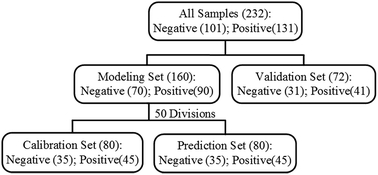ATR-FTIR spectroscopy with equidistant combination PLS method applied for rapid determination of glycated hemoglobin
Abstract
A rapid quantification method of glycated hemoglobin (HbA1c) is proposed based on ATR-FTIR spectroscopy in human hemolysate samples. HbA1c, a major clinical diagnostic indicator of diabetes, is a relative content indicator, which was indirectly determined by determining the hemoglobin (Hb) and absolute HbA1c content (Hb·HbA1c) using ATR-FTIR spectroscopy. The equidistant combination partial least squares (EC-PLS) method was employed in wavelength selection to improve the modeling performance. Modeling samples were divided into calibration and prediction sets 50 times repeatedly to increase the model stability. For Hb and Hb·HbA1c, 90 and 198 wavenumbers were screened out by EC-PLS, respectively. The predicted values of HbA1c were calculated based on the predicted Hb and Hb·HbA1c values. The root-mean-square errors (RMSEP) and correlation coefficients of prediction (RP) were 5.9 g L−1 and 0.945 for Hb, 1.32 g L−1 and 0.931 for Hb·HbA1c, and 0.67% and 0.918 for HbA1c, respectively, for the validation samples. The results indicated the feasibility of quantification of HbA1c with ATR-FTIR spectroscopy. This method is simpler and quicker than conventional methods. Thus, this process is a potential diabetes screening tool in large populations.

- This article is part of the themed collection: Analytical Methods Recent HOT articles


 Please wait while we load your content...
Please wait while we load your content...